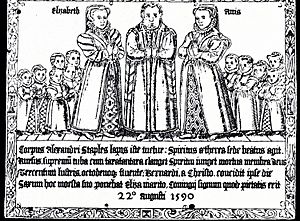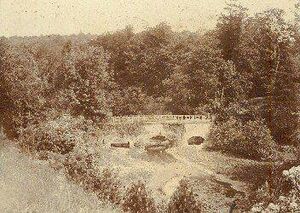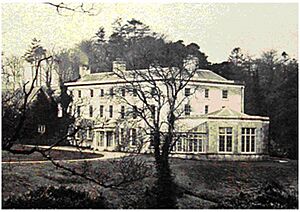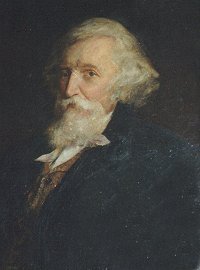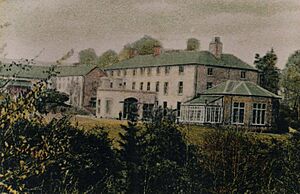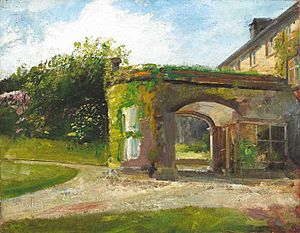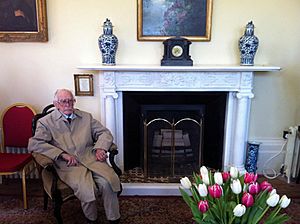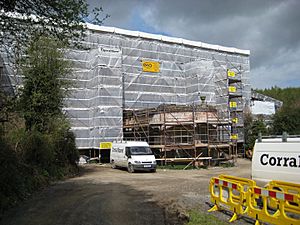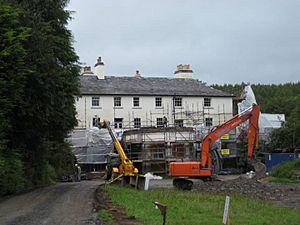Lissan House facts for kids
Quick facts for kids Lissan House |
|
|---|---|

Lissan House
|
|
| General information | |
| Type | House |
| Architectural style | Ulster Plantation House with Georgian and Victorian additions |
| Location | Cookstown, County Tyrone |
| Coordinates | 54°40′58″N 6°45′52″W / 54.682702°N 6.764539°W |
| Construction started | Evidence of building on site c.1580; first constructed c.1620; reconstructed c.1690 with notable alterations in c.1780, c.1840 and c.1880 |
| Governing body | Lissan House Trust |
| Design and construction | |
| Architect | Alterations by Davis Ducart |
Lissan House is a very old and interesting house in County Tyrone, Northern Ireland. It used to be the home of the Staples family, who were important people called Baronets. Lissan House is tucked away near the Sperrin Mountains, surrounded by old woods, close to the town of Cookstown. Today, it's a popular place for visitors to explore.
Contents
The Staples Family and Lissan House's Beginnings
Lissan House was home to the Staples family for a very long time, from about 1620 until 2006. This is one of the longest times a single family has lived in a house in Ireland.
How the Staples Family Arrived
Thomas Staples came from England around 1610. He was part of the plantation of Ulster, a time when people from England and Scotland settled in Ireland. He first lived in Moneymore in County Londonderry. His stone house is even shown on an old map from 1622.
Around 1622, Thomas Staples married Charity Jones. In 1628, King Charles I made him the first Baronet of Lissan and Faughanvale. This was a special title given by the King. Around the same time, he bought land, including the area where Cookstown is now and about 180 acres at Tatnagilta, which is the Lissan estate.
Early Days and Challenges
It's believed there was already a house and an iron forge (a place to melt iron) on the estate. The forge was important because it helped the house survive the Rebellion of 1641. During this rebellion, the estate was taken over by rebels. Lady Staples and her four children were held captive for almost two years. The rebels used the estate to make weapons like pikes, which meant the buildings were not destroyed, unlike other nearby towns.
Building the Present House
The house you see today was largely built by Sir Thomas's grandson, Sir Robert Staples, the fourth Baronet. He married Mary Vessey and made many improvements to the estate. Around 1690, he built the main part of the current house, using parts of the older dwelling. He also created a large, 5-acre walled garden that is still there.
A huge oak staircase was a main feature of his house. It still dominates the house today, even after being rebuilt in the 1880s. In 1703, someone wrote that Sir Robert had built "a very good stone house; the rooms are noble, lofty and large."
Lissan House in the 1700s
For almost 100 years, there were legal problems over who owned the Lissan estate. This was due to a mistake in a marriage agreement from 1682. Eventually, in 1774, the courts decided that Lissan would be the home of a different branch of the Staples family.
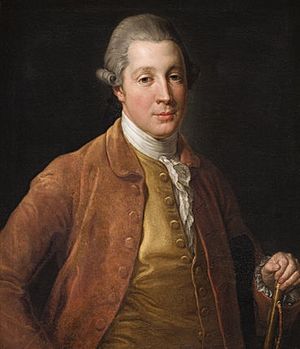
John Staples and His Contributions
The Rt. Hon. John Staples became the new owner. He was a very skilled lawyer and a long-serving member of the Irish House of Commons, which was like the parliament of Ireland at the time. He traveled to Italy twice and brought back many beautiful books, paintings, and marble statues for Lissan. He was even painted by a famous Italian artist, Pompeo Batoni.
John Staples married twice and had many children who married into important Irish families. He is also the great-great-grandfather of the famous writer C.S. Lewis.
Architectural Additions
John's father, Rev. Thomas Staples, worked with others to start the Tyrone Mining Company. They brought an architect named Davis Ducart from Italy. Ducart designed the beautiful White Bridge on the Lissan Estate and a special water garden with fountains. These features are still on the estate today.
Changes and Challenges in the 1800s
The eighth Baronet, Sir Robert, passed away without children. So, the title of Baronet and the Lissan Estate went to John Staples's oldest son, Thomas. He became the ninth Baronet and brought the title back to Lissan.
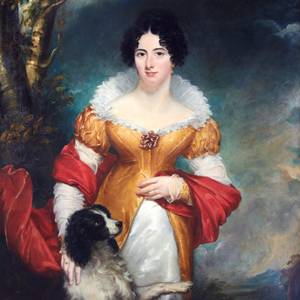
Sir Thomas Staples's Improvements
Sir Thomas Staples was a well-known lawyer. He made several important additions to Lissan House, especially a large ballroom. This room was built to have great views of the water gardens. It was very fancy, with an early central heating system and special floorboards that made dancing easier. The room was decorated in a striking red and black style, with expensive hand-painted Chinese wallpaper.

Sir Thomas's younger brother, Rev. John Molesworth Staples, asked a famous architect named John Nash to design the Lissan Rectory and the local church in Cookstown. Nash was known for designing grand buildings.
The Estate's Decline and New Additions
When Sir Thomas died in 1865 without children, his wife Catherine inherited all the money and contents of the house. The title and estate went to his nephew, Nathaniel, who became the 10th Baronet.
Financial Difficulties
When Catherine died, she left the house's contents to a relative, Harriet Gage. This meant Sir Nathaniel inherited a large house with very little furniture or money. This started a quick financial decline for the estate.
Despite money problems, Sir Nathaniel added a porte cochère (a covered entrance for carriages) to the front of the house. He also bought a clock tower from a nearby town and added it to the house. This clock was made in 1820, and its bell can still be heard today.
By the time Sir Nathaniel died in 1899, the family was almost completely out of money. To make things worse, the next Baronet, Sir John Staples, was unwell and spent his life in care homes.
Keeping the Estate Going
Because of this, James Head Staples, Sir Nathaniel's second son, took over the estate. He and his wife worked hard to keep it going. They built a creamery and took in boarders. Mrs. Staples taught local girls cooking and lace-making skills. James also installed a water turbine in 1902, which provided electricity to the house until 2004 and still works today!
Sir Robert Ponsonby Staples: The Artist Baronet
By 1911, James Head Staples was too ill to manage the estate. His younger brother, Robert Ponsonby Staples, moved to Lissan in 1912. Robert Ponsonby Staples was an incredibly talented artist. He studied art in Europe and became a famous portrait artist in London.
A Famous Artist and Socialite
His paintings are now very valuable. His most famous work, An Imaginary Cricket Match, is at Lord's Cricket Ground. Other large paintings are in important places like the House of Lords. Robert Ponsonby was also a well-known socialite and friend of King Edward VII. He was famous for refusing to wear shoes, believing it was good for his health!
Even though his art was valuable, he didn't become rich from it. After moving to Lissan, his money ran out. He often had to pawn his own paintings to get funds. A big sale was held during his time, where many of the remaining paintings and furniture were sold off. He became the Baronet in 1933 at age 80 and passed away 10 years later.
Lissan House in Recent Times
By 1943, the estate had lost most of its furnishings and land and was nearly bankrupt. Sir Robert Ponsonby Staples's son, Sir Robert George Alexander Staples, the 13th Baronet, couldn't afford to live at Lissan. He hired a relative, Harry Radclyffe-Dolling, to manage the estate and moved to England for work.
Dividing the House
Harry Dolling divided the house into many small apartments. From 1943 until the late 1960s, over a hundred people lived in these flats, which were made from the house's grand rooms. Many of the remaining valuable items were sent to a nearby house, Springhill House, for safekeeping and were never returned.
Sir Robert George Alexander worried he would be the last Staples owner of Lissan. He had two daughters, but neither was interested in the crumbling estate. However, after his death in 1970, his elder daughter, Hazel, visited Lissan and met Harry Dolling. They married within a year and moved into Lissan, making it a single family home again.
The End of the Baronetcy
While Hazel inherited the house, the Baronetcy (the special title) passed to a distant cousin. Over the years, the title passed through several cousins, all of whom were quite old when they inherited it and had no male heirs. The 17th Baronet, Sir Richard Molesworth Ponsonby Staples, inherited the title in 1999 at age 85.
Since there were no more male heirs, when Sir Richard Molesworth Staples died in 2013, the Baronetcy was declared "dormant." This means there is no one currently holding the title.
Saving Lissan House
After her husband and mother passed away, Hazel lived alone at Lissan from 1990. By 1997, she realized no family member could afford to take care of the estate. Hazel had dedicated her life to preserving this unique and historic property. So, she decided to create a Charitable Trust to find a way to save Lissan House for the future.
Public Attention and Restoration Efforts
In 2003, Lissan House was featured on a TV show called Restoration. The show promised a large sum of money to the winning property for restoration. Lissan and Hazel, its owner, became very popular with the public. Lissan made it to the grand final but narrowly lost. While the show brought a lot of attention to Lissan, it didn't provide any funding.
The Charitable Trust was re-formed in 2004 as the Lissan House Trust. Hazel Radclyffe-Dolling passed away in April 2006. In her will, she left the entire estate to the Trust, but only if they could secure a plan for its restoration within three years.
Lissan House is a special part of Ulster's history. In August 2007, the Lissan House Trust opened the house to the public for the first time. Almost 5,000 visitors came in just eight days, showing how popular Lissan could be as a tourist attraction.
In 2010, the first stage of restoration began. Major work was done to make the building safe, fix the roof, and repair the walls and windows. The inside of the house was also updated, forest trails were created, and an adventure playground was built. An exhibition was also set up inside the house to tell its story.
The Trust is currently looking for funding for the second stage of restoration. This stage will focus on restoring the interior decorations, rebuilding the Conservatory, and fully restoring the farmyard and other buildings.
Lissan House officially opened to the public as a tourist attraction and events venue in Spring 2012.


